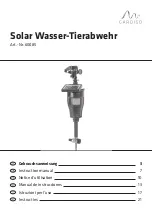
16
AGW–4015/4025/4045
Installation & Operations Manual
7B. General Safety Information
7B-1. Ozone Properties
• Colorless to blue gas (greater than -169°F)
• Characteristic odor often associated with
electrical sparks or lightning in concentrations of
less than 2 ppm
• Severe irritant above 1-2 ppm
• Generally exists as a gas
• Highly chemically reactive
• Non-flammable, non-carcinogenic
• Hazardous polymerization can occur
• Spontaneously decomposes to oxygen gas
7B-2. Ozone Uses
• Air and water disinfection
• Surface sanitation
• Water treatment plants
• Bottled water, irrigation, community water
supplies, swimming pools/spas, etc.
• Aquariums/life support
• Agricultural wash water
• Wastewater treatment
• Mold and bacteria control in cold storage
7B-3. AGW–4015/4025/4045 Safety Features
The AGW–4015/4025/4045 produce ozone which
is automatically and immediately injected into the
water flow. Any ozone which does not dissolve into
the water is separated off in the degas chamber
and eliminated in the heated catalytic ozone
destruct. The design of this self-contained system
eliminates the release of gaseous ozone from
the unit. In addition to ozone safety, the following
general safety features are built-in to the AGW–
4015/4025/4045:
• Ozone Generator door safety interlock switch -
disables high voltage power supply when open or
improperly latched
• Circuit Breaker, Fuse
• Vacuum Switch - stops operation in the event of
low water flow
• Ozone cell high temperature indicator
• Interlocked sensors and regulating devices
• Startup/shutdown sequences and fault protection
• Multistage water pump to control flow rate
• Ozone is supplied under negative pressure
(induction - i.e. a leak will draw air into the
system).
Slight off-gassing of ozone can occur from the
water that is produced by the AGW–4015
/4025/4045 (the physical properties of ozone
make this unavoidable). Laboratory and field
testing in varying environments indicate that ozone
off-gas levels from the water produced by the
AGW–4015/4025/4045 do not exceed 0.1 PPM (the
permissible exposure level (PEL) or time weighted
concentration for gaseous ozone to which workers
may be exposed averaged over 8 hours, 5 days
a week (OSHA)). Gaseous ozone concentrations
above 0.02 PPM are detectable by humans.
Inasmuch, Sections 7C through 7H of this manual
discuss relative issues regarding safety and
monitoring of gaseous ozone.
7C. Hazards
7C-1. Health Hazards - Detection Levels
Gaseous ozone can be detected in air by its
distinctive odor at concentrations of about 0.02
ppm. Although each nose varies, olfactory fatigue
occurs quickly. Initial small exposure may reduce
cell sensitivity and/or increase mucous thickness
producing a resistance to low gaseous ozone
levels. As a result, DO NOT RELY ON ODOR AS A
WARNING OF HIGH OZONE CONCENTRATIONS.
The permissible exposure level (PEL) or time
weighted concentration for gaseous ozone to which
workers may be exposed is 0.1 ppm averaged
over 8 hours, 5 days a week (OSHA). The short
term exposure limit is 0.3 ppm averaged over 15
minutes. The concentration of 5 ppm ozone in air is
generally accepted as Immediately Dangerous to
Life or Health (IDLH).
7C-2. Health Hazards - Effects on Humans
Gaseous ozone acts as a primary irritant, affecting
mainly the eyes, upper respiratory tract and the
lungs. Inhalation produces various degrees of
respiratory effects from irritation to pulmonary
edema (fluid in lungs). Short exposure to 1-2
ppm concentrations causes headache as well as
irritation to the respiratory system but symptoms
subside when exposure ends. High concentrations
of ozone produce severe irritation to the eyes
and respiratory system. Exposure above the
ACGIH/OSHA limits may produce nausea, chest
pain, coughing, fatigue, reduced visual acuity
and pulmonary edema. Symptoms of edema
from excessive exposure can be delayed one or
more hours. There is no threshold limit and so no
exposure (regardless of how small) is theoretically
without effect from ozone’s strong oxidative ability.
Содержание AGW Series
Страница 2: ......
Страница 7: ...3 AGW 4015 4025 4045 Installation Operations Manual 3A Tank Charging System ...
Страница 8: ...4 AGW 4015 4025 4045 Installation Operations Manual 3B Tank Cleaning System ...
Страница 9: ...5 AGW 4015 4025 4045 Installation Operations Manual 3C Spray System ...
Страница 15: ...11 AGW 4015 4025 4045 Installation Operations Manual 60 Hz Electrical Diagram ...
Страница 16: ...12 AGW 4015 4025 4045 Installation Operations Manual 60 Hz Electrical Diagram cont ...
Страница 17: ...13 AGW 4015 4025 4045 Installation Operations Manual 50 Hz Electrical Diagram ...
Страница 18: ...14 AGW 4015 4025 4045 Installation Operations Manual 50 Hz Electrical Diagram cont ...
Страница 25: ...21 AGW 4015 4025 4045 Installation Operations Manual APPENDIX A DAILY DATA LOG ...
Страница 26: ...22 AGW 4015 4025 4045 Installation Operations Manual ...
Страница 27: ...23 AGW 4015 4025 4045 Installation Operations Manual APPENDIX B EMERGENCY INFORMATION ...
Страница 28: ...24 AGW 4015 4025 4045 Installation Operations Manual ...
Страница 29: ...25 AGW 4015 4025 4045 Installation Operations Manual APPENDIX C SAFETY ...
Страница 35: ......
















































